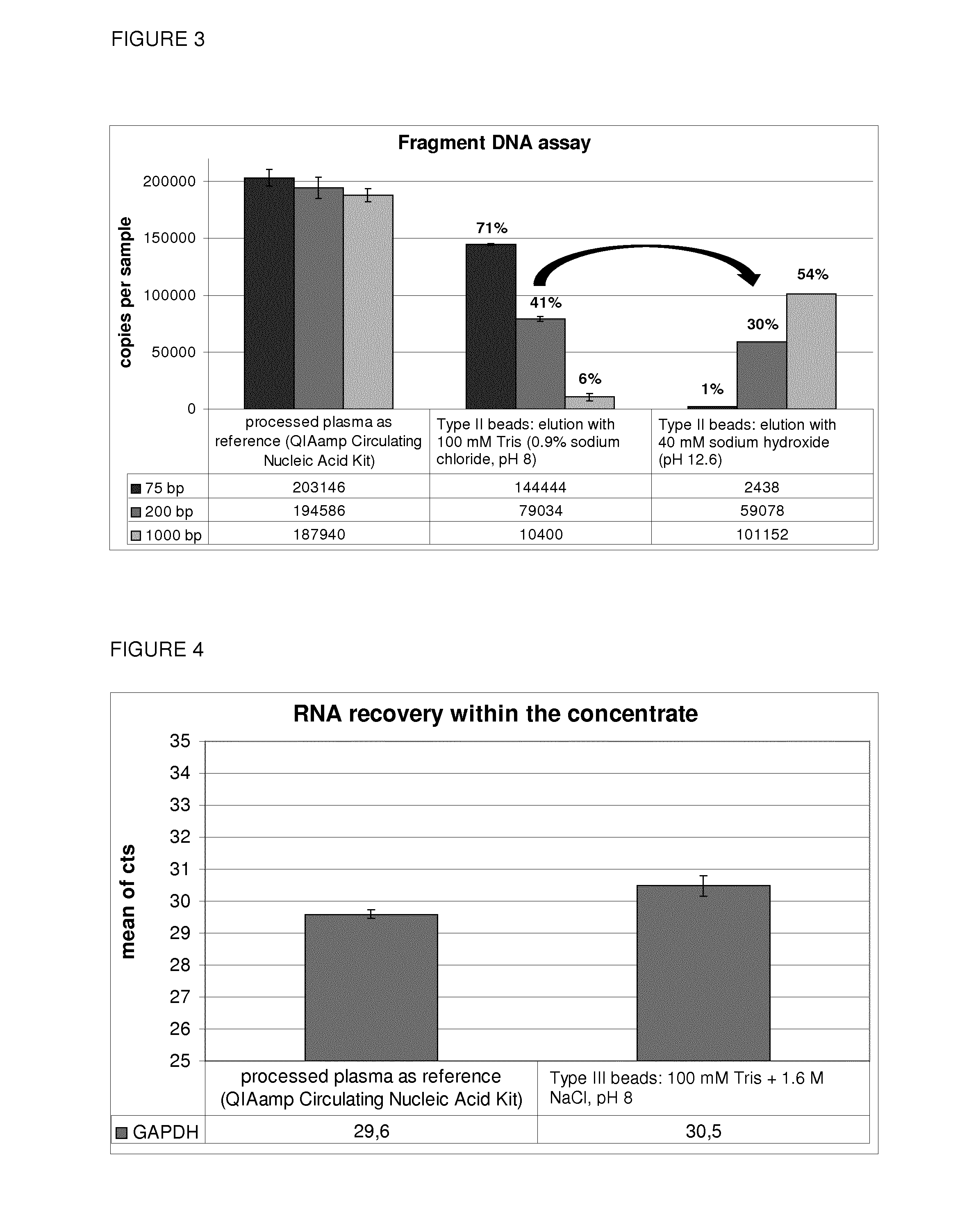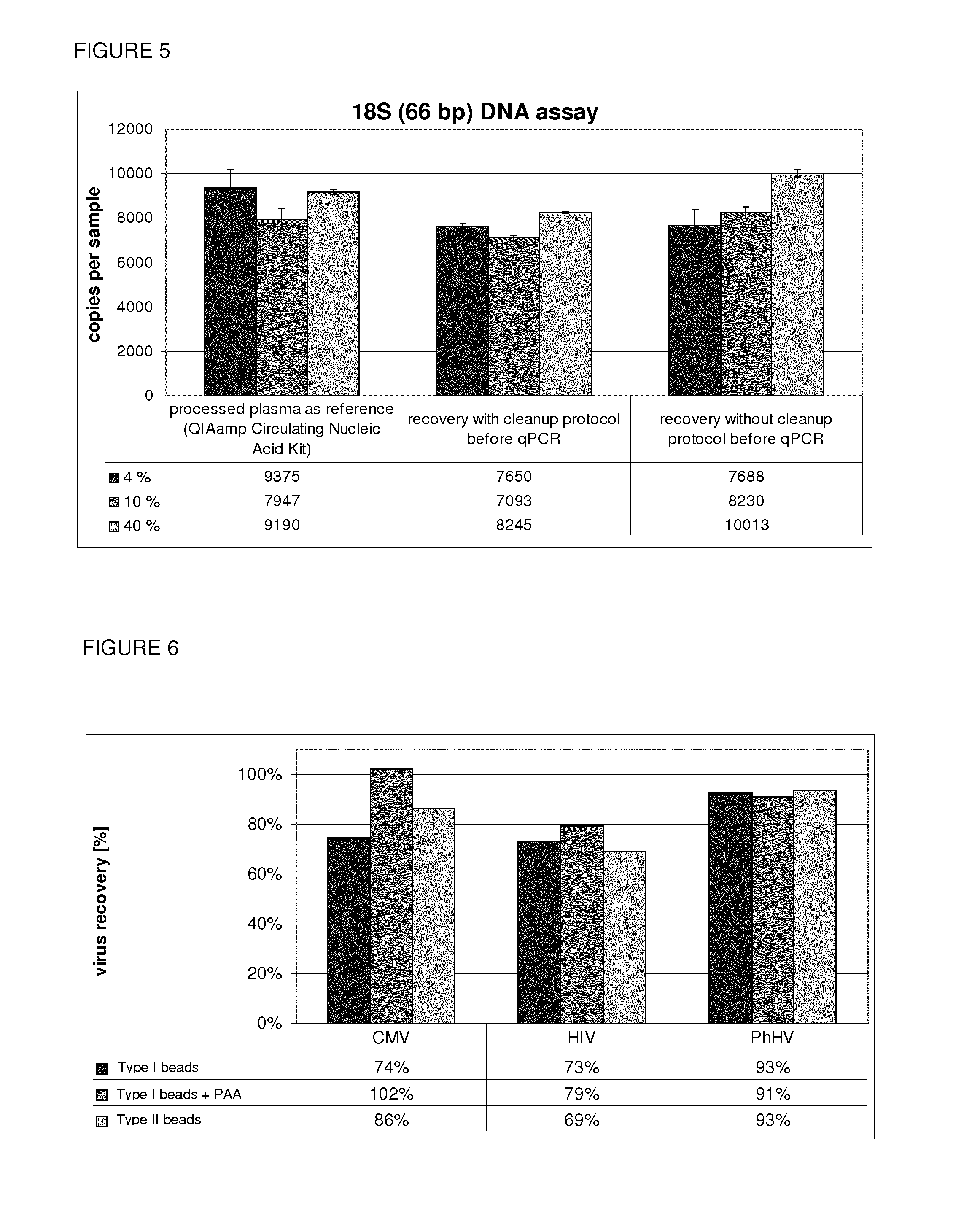Rapid method for isolating extracellular nucleic acids
a nucleic acid and extracellular technology, applied in the field of isolating extracellular nucleic acids, can solve the problems of difficult implementation of automated large-volume sample preparation, drawbacks which need improvement, and standard robotic systems can only process, so as to achieve efficient isolation
- Summary
- Abstract
- Description
- Claims
- Application Information
AI Technical Summary
Benefits of technology
Problems solved by technology
Method used
Image
Examples
example 1
Yields of the Nucleic Acid Extraction Depending on the Used Beads
[0174]For nucleic acid isolation, the following protocol was performed.[0175]4 ml of pooled plasma is centrifuged at 16,000 g at 4° C. for 10 min. to remove residual cells and the cell-depleted plasma is transferred into a 15 ml falcon tube[0176]100 μl of 1 M sodium acetate / acetic acid buffer (pH 4) is added to adjust the pH to a value between 5 and 6 (˜25 mM NaOAc / HOAc in 4 ml sample)[0177]8 mg each of both magnetic Beads (Type I) types, 4 mg of the magnetic Beads (Type II) beads or 4 mg of Magnetic Beads (Type III) are then used for binding[0178]Binding is performed for 20 min. at room temperature on an overhead rotational shaker (20 rpm)[0179]Then the beads are separated for 10 min. in a magnetic falcon tube rack and the supernatant is discarded[0180]1 ml of 100 mM Tris-HCl (with 0.9% sodium chloride and at pH 8.5) is added[0181]The solution is transferred into a 1.5 ml Eppendorf tube and the nucleic acids are elute...
example 2
Enrichment of ccfDNA
[0187]Then the magnetic Beads (Type II) were used for the enrichment of ccf DNA. Therefore, the same protocol as described in Example 1 was used with the following changes:[0188]The nucleic acid were not only extracted from the eluate, but also from the plasma supernatant after the binding step. This allows to assess the binding and elution efficiency.[0189]After purifying the eluate using the QIAamp Circulating Nucleic Acid Kit, the nucleic acids were now eluted in a smaller volume (60 μl AVE).
[0190]With this experiment, the results of the internal control (75, 200 and 1000 bp fragments) were confirmed by the analysis of ccfDNA. Thereby, not only a ˜100% DNA recovery was affirmed, it was also shown, that there was no loss of beads during the binding step. In FIG. 2, a DNA assay was used to detect circulating cell-free DNA. Two different DNA amplicons (66 and 500 bp) of the 18S rRNA coding sequence were quantified. The reference was used to determine the total am...
example 3
Size-Selective Elution of DNA
[0192]An unexpected size selective behavior of the magnetic Beads (Type II) was discovered using almost the same protocol as for the enrichment of ccfDNA. The only difference was that the nucleic acids were eluted in two steps from the beads using two different elution buffers. FIG. 3 shows the results of the DNA fragment assay.
[0193]In a first step it was possible to achieve a preferred elution of shorter DNA fragments using the already mentioned elution buffer (100 mM Tris-HCl, containing 0.9% sodium chloride), but at pH 8. The remaining and especially longer DNA fragments were finally eluted at an alkaline pH (12.6) using 40 mM sodium hydroxide. However, as is shown in the other examples, also lower pH values of e.g. 8.5 can be used for an efficient elution. The use of lower pH values below 10 and preferably below 9 is favourable for downstream reactions.
[0194]400 μl Magnetic Beads (Type III) neutralisation-buffer (pH 8.5) was added to the 600 μl elua...
PUM
| Property | Measurement | Unit |
|---|---|---|
| Fraction | aaaaa | aaaaa |
| Fraction | aaaaa | aaaaa |
| Fraction | aaaaa | aaaaa |
Abstract
Description
Claims
Application Information
 Login to View More
Login to View More - R&D
- Intellectual Property
- Life Sciences
- Materials
- Tech Scout
- Unparalleled Data Quality
- Higher Quality Content
- 60% Fewer Hallucinations
Browse by: Latest US Patents, China's latest patents, Technical Efficacy Thesaurus, Application Domain, Technology Topic, Popular Technical Reports.
© 2025 PatSnap. All rights reserved.Legal|Privacy policy|Modern Slavery Act Transparency Statement|Sitemap|About US| Contact US: help@patsnap.com



